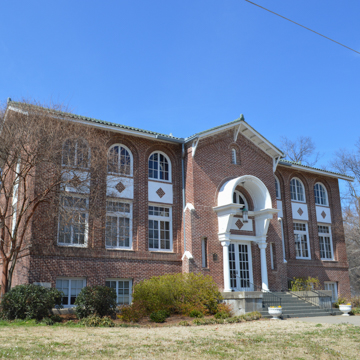Not only is this church, located one block north of Portland’s tiny commercial district, the largest building in town, but its setting behind an expansive lawn adds to its aura of monumentality. The two-story red brick building with a full basement is T-shaped in massing and covered with a cross-gabled green ceramic tile roof. The long facade on Main Street, which is lined with two floors of round-arched windows, makes the building look more like a school than a church, an effect heightened by the central projecting entrance bay with a pair of French doors. Sheltering the entrance is a round-arched hood supported on slender columns with cushion capitals and wooden brackets. The sanctuary stretches out behind the building’s front portion and is illuminated by tall arched windows filled by simple panes of opalescent stained glass in shades of pale lavender, rose, gold, and green, reminiscent of a Delta landscape and resplendent at sunset. In addition to this church, Almand obtained several commissions in the state for churches that departed from the conventional Gothic-inspired designs. Two other Tudor-styled churches are the First Presbyterian (1919; 304 S. Center Street) in Lonoke and the First United Methodist (DA3) in Fordyce.
You are here
Portland United Methodist Church
If SAH Archipedia has been useful to you, please consider supporting it.
SAH Archipedia tells the story of the United States through its buildings, landscapes, and cities. This freely available resource empowers the public with authoritative knowledge that deepens their understanding and appreciation of the built environment. But the Society of Architectural Historians, which created SAH Archipedia with University of Virginia Press, needs your support to maintain the high-caliber research, writing, photography, cartography, editing, design, and programming that make SAH Archipedia a trusted online resource available to all who value the history of place, heritage tourism, and learning.





















